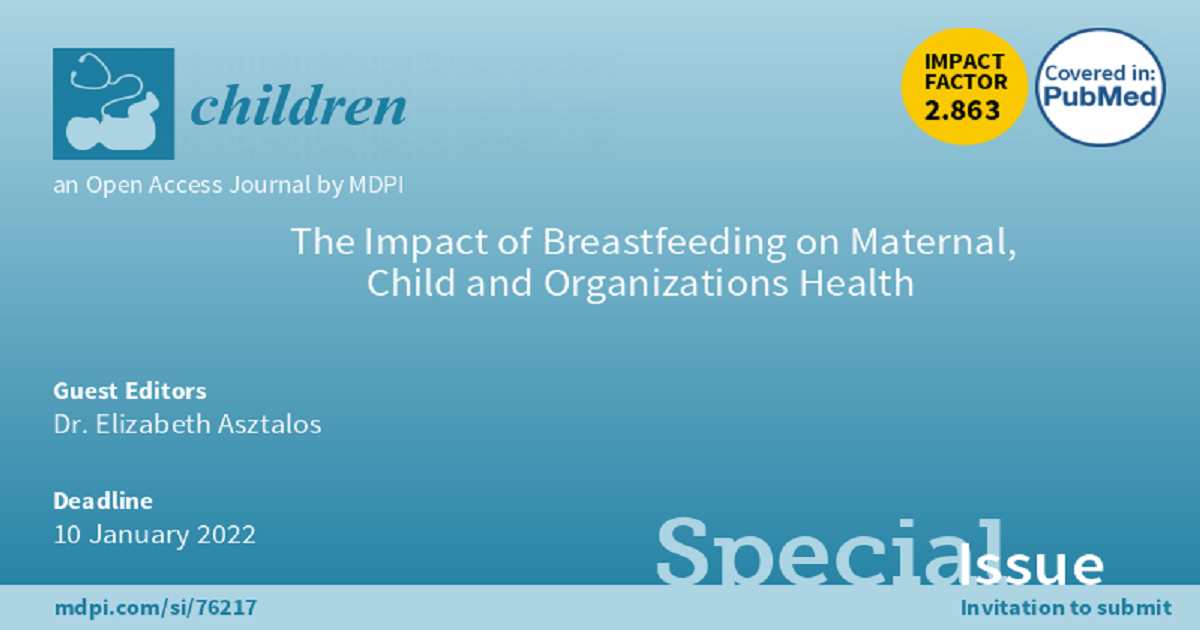The Impact of Breastfeeding on Maternal, Child and Organizations Health
A special issue of Children (ISSN 2227-9067). This special issue belongs to the section "Global Pediatric Health".
Deadline for manuscript submissions: closed (10 January 2022) | Viewed by 24449

Special Issue Editors
Interests: neonatal care; neurodevelopmental outcomes; clinical trials; feeding and nutritional support
Special Issues, Collections and Topics in MDPI journals
Special Issue Information
Dear Colleagues,
The benefits of breastfeeding for mothers and babies are unquestionable, as shown by numerous reviews and research on the subject; however, due to the impact on the health of both mothers and babies, it is important to continue to assess these benefits for both. Moreover, situations such as the COVID-19 pandemic present the opportunity to obtain new scientific evidence of the impact of breastfeeding.
The benefits of breastfeeding extend beyond solely mothers and babies; there is much discussion nowadays regarding its impact on the health of organizations, understanding organizational health in the broadest sense.
In addition, from a social justice perspective, working mothers must be supported by the organizations in which they work; their health may be affected by the need to work, but organizations can make efforts to improve their health, in the form of sick leave or requests for childcare days to ensure the health of breastfed children. As a result, mothers may be able to carry out their work more effectively, in turn benefitting the organizations in which they work.
The objective of this Special Issue is to bring together a series of novel research and reviews as well as to identify gaps in knowledge on the impact of breastfeeding on maternal and child health. We will also consider the impact on organizations that favor the continuation of breastfeeding in employees who are mothers. We welcome reviews and original research considering novel approaches to this subject.
We also encourage submissions that explore how the return to work of mothers who wish to continue breastfeeding their children can have an impact on their health and how feeling supported in their return to work can impact the results of the organization.
I look forward to receiving your contributions.
Dr. Elizabeth Asztalos
Chief Guest Editor
Dr. Ana Lisbona
Co-Guest Editor
Manuscript Submission Information
Manuscripts should be submitted online at www.mdpi.com by registering and logging in to this website. Once you are registered, click here to go to the submission form. Manuscripts can be submitted until the deadline. All submissions that pass pre-check are peer-reviewed. Accepted papers will be published continuously in the journal (as soon as accepted) and will be listed together on the special issue website. Research articles, review articles as well as short communications are invited. For planned papers, a title and short abstract (about 100 words) can be sent to the Editorial Office for announcement on this website.
Submitted manuscripts should not have been published previously, nor be under consideration for publication elsewhere (except conference proceedings papers). All manuscripts are thoroughly refereed through a single-blind peer-review process. A guide for authors and other relevant information for submission of manuscripts is available on the Instructions for Authors page. Children is an international peer-reviewed open access monthly journal published by MDPI.
Please visit the Instructions for Authors page before submitting a manuscript. The Article Processing Charge (APC) for publication in this open access journal is 2400 CHF (Swiss Francs). Submitted papers should be well formatted and use good English. Authors may use MDPI's English editing service prior to publication or during author revisions.
Keywords
- breastfeeding
- mother health
- child health
- organizational health
Benefits of Publishing in a Special Issue
- Ease of navigation: Grouping papers by topic helps scholars navigate broad scope journals more efficiently.
- Greater discoverability: Special Issues support the reach and impact of scientific research. Articles in Special Issues are more discoverable and cited more frequently.
- Expansion of research network: Special Issues facilitate connections among authors, fostering scientific collaborations.
- External promotion: Articles in Special Issues are often promoted through the journal's social media, increasing their visibility.
- e-Book format: Special Issues with more than 10 articles can be published as dedicated e-books, ensuring wide and rapid dissemination.
Further information on MDPI's Special Issue policies can be found here.







